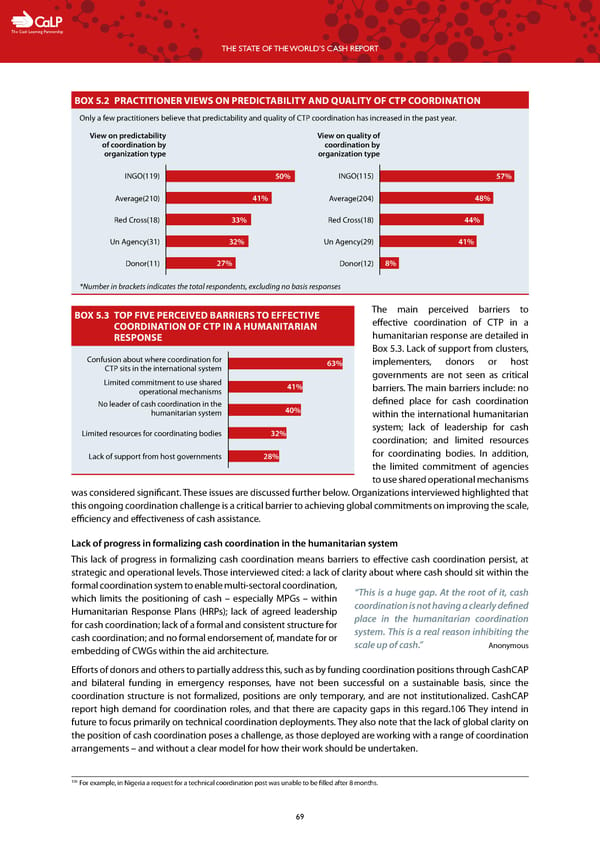C The Cash Learning Partnership THE STATE OF THE WORLD’S CASH REPORT BOX 5.2 PRACTITIONER VIEWS ON PREDICTABILITY AND QUALITY OF CTP COORDINATION Only a few practitioners believe that predictability and quality of CTP coordination has increased in the past year. View on predictability View on quality of of coordination by coordination by organization type organization type INGO(119) 50% INGO(115) 57% Average(210) 41% Average(204) 48% Red Cross(18) 33% Red Cross(18) 44% Un Agency(31) 32% Un Agency(29) 41% Donor(11) 27% Donor(12) 8% *Number in brackets indicates the total respondents, excluding no basis responses BOX 5.3 TOP FIVE PERCEIVED BARRIERS TO EFFECTIVE The main perceived barriers to COORDINATION OF CTP IN A HUMANITARIAN effective coordination of CTP in a RESPONSE humanitarian response are detailed in Box 5.3. Lack of support from clusters, Confusion about where coordination for 63% implementers, donors or host CTP sits in the international system governments are not seen as critical Limited commitment to use shared 41% barriers. The main barriers include: no operational mechanisms No leader of cash coordination in the defined place for cash coordination humanitarian system 40% within the international humanitarian Limited resources for coordinating bodies 32% system; lack of leadership for cash coordination; and limited resources Lack of support from host governments 28% for coordinating bodies. In addition, the limited commitment of agencies to use shared operational mechanisms was considered significant. These issues are discussed further below. Organizations interviewed highlighted that this ongoing coordination challenge is a critical barrier to achieving global commitments on improving the scale, efficiency and effectiveness of cash assistance. Lack of progress in formalizing cash coordination in the humanitarian system This lack of progress in formalizing cash coordination means barriers to effective cash coordination persist, at strategic and operational levels. Those interviewed cited: a lack of clarity about where cash should sit within the formal coordination system to enable multi-sectoral coordination, “This is a huge gap. At the root of it, cash which limits the positioning of cash – especially MPGs – within coordination is not having a clearly defined Humanitarian Response Plans (HRPs); lack of agreed leadership place in the humanitarian coordination for cash coordination; lack of a formal and consistent structure for system. This is a real reason inhibiting the cash coordination; and no formal endorsement of, mandate for or scale up of cash.” Anonymous embedding of CWGs within the aid architecture. Efforts of donors and others to partially address this, such as by funding coordination positions through CashCAP and bilateral funding in emergency responses, have not been successful on a sustainable basis, since the coordination structure is not formalized, positions are only temporary, and are not institutionalized. CashCAP report high demand for coordination roles, and that there are capacity gaps in this regard.106 They intend in future to focus primarily on technical coordination deployments. They also note that the lack of global clarity on the position of cash coordination poses a challenge, as those deployed are working with a range of coordination arrangements – and without a clear model for how their work should be undertaken. 106 For example, in Nigeria a request for a technical coordination post was unable to be filled after 8 months. 69
 The State of the World's Cash | Full Report Page 70 Page 72
The State of the World's Cash | Full Report Page 70 Page 72